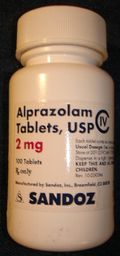|
Find information on thousands of medical conditions and prescription drugs.
|
|
|
Alprazolam
Alprazolam is a short-acting benzodiazepine used to treat anxiety disorders. It is generally sold in generic form (i.e., alprazolam) in the United States (to cut down on costs for insurance companies) and also under many other brand names, depending on the country: more...
 Home Home
 Diseases Diseases
 Medicines Medicines
 A A
 B B
 C C
 D D
 E E
 F F
 G G
 H H
 I I
 J J
 K K
 L L
 M M
 N N
 O O
 P P
 Q Q
 R R
 S S
 T T
 U U
 V V
 W W
 X X
 Alprazolam Alprazolam
 Xeloda Xeloda
 Xeloda Xeloda
 Xeneisol Xeneisol
 Xenical Xenical
 Xylazine Xylazine
 Xylocaine Xylocaine
 Xylometazoline Xylometazoline
 Xyrem Xyrem
 Y Y
 Z Z
- Xanax® - United States, Australia, United Kingdom
- Xanax XR® - (an extended release formulation) United States
- Apotex® - Canada
- Xanor® - Finland, Philippines, South Africa, Sweden
- Kalma® - Australia, New Zealand
- Ralozam® - Australia, New Zealand
- Zamhexal® - Australia
- Alplax® - Argentina
- Alviz® - Indonesia
- Alzolam® - India, Malaysia
- Alprax® - India
- Tranax® - India
- Restyl® - Bahrain, Cyprus, Egypt, Iran, Iraq, Jordan, Kuwait, Lebanon, Libya, Oman, Qatar, Republic of Yemen, Saudi Arabia, Syria, United Arab Emirates
- Tranquinal® - Ecuador, Peru
- Trankimazin® - Spain
- Tafil® - Costa Rica, Denmark, El Salvador, Germany, Guatemala, Honduras, Mexico, Nicaragua, Panama, Venezuela
- Tafil AP® - (an extended release formulation) Mexico
- Constan® - Japan
- Solanax® - Japan
- Zolarem® - Bahrain, Benin, Burkina-Faso, Cyprus, Egypt, Ethiopia, Gambia, Ghana, Guinea, Iran, Iraq, Israel, Ivory Coast, Jordan, Kenya, Kuwait, Lebanon, Liberia, Libya, Malawi, Mali, Mauritania, Mauritius, Morocco, Niger, Nigeria, Oman, Qatar, Republic of Yemen, Saudi Arabia, Senegal, Seychelles, Sierra-Leone, South Africa, Sudan, Syria, Tanzania, Tunia, Uganda, United Arab Emirates, Zambia, Zimbabwe
- Zoldac® - Benin, Burkina-Faso, Ethiopia, Gambia, Ghana, Guinea, India, Ivory Coast, Kenya, Liberia, Malawi, Mali, Mauritania, Mauritius, Morocco, Niger, Nigeria, Senegal, Seychelles, Sierra-Leone, South Africa, Sudan, Tanzania, Tunia, Uganda, Zambia, Zimbabwe
Alprazolam has a calming effect, with the most common side effects being drowsiness, clumsiness, and to a lesser extent, fatigue, and headache. It can also have more adverse effects, such as blurred vision, slurred speech or dysarthria, and changes in personality. It may be habit forming and users often develop a tolerance to its initial effects, although its anxiolytic efficacy remains intact. Physical and/or psychological dependence may develop after several weeks of alprazolam treatment. There is now a general consensus among many psychiatrists that alprazolam (a so-called 'high-potency' benzodiazepine) poses a particularly high risk for abuse and dependence. Withdrawal after long-term use should be done slowly over a period of weeks to avoid serious withdrawal symptoms such as agitation, rebound anxiety, muscle cramps and possible seizures. Some patients may benefit from a more gradual dosage reduction and/or discontinuation and substitution with diazepam.
Read more at Wikipedia.org
• [List your site here Free!]
|
|
|
|
Alprazolam vs. progesterone in the treatment of PMS - adapted from the Journal of the American Medical Association, July 5, 1995 - Tips from Other Journals
From American Family Physician,
11/15/95
Premenstrual syndrome (PMS) affects approximately 10 percent of women of child-bearing age. Use of progesterone in the treatment of the symptoms of PMS has been advocated, even though trials have not shown that it is more effective than placebo, except for relief of the specific symptoms of hot flushes, water retention and swelling. In contrast, some studies have shown that alprazolam, an anxiolytic/antipanic medication, is effective in the treatment of PMS. In a randomized, double-blind trial, Freeman and colleagues compared the effectiveness of oral micronized progesterone with that of alprazolam and placebo in the treatment of PMS.
A total of 444 women seen at an outpatient obstetrics-gynecology department requested evaluation for PMS and were instructed to record their symptoms for two cycles. Women were included in the study if they were between 18 and 45 years of age, had regular menses and had moderate to severe symptoms of PMS for at least six months. After tracking symptoms for two cycles, the women had two office evaluations; after evaluation, 284 of these women still met criteria for the study. Placebo was then given to each of these patients. Of the 284 women, 56 had a placebo response and were excluded from the study, and 43 dropped out for other reasons, leaving 185 (42 percent of the original group) who completed the study
Seventeen different symptoms were rated daily on a scale of zero (for lack of a symptom) to four (for severe symptoms). Premenstrual and postmenstrual scores were calculated, based on five-day periods before and after menses. PMS was defined as a premenstrual score of at least 70, a premenstrual score at least 50 percent greater than the postmenstrual score and premenstrual functional impairment. Patients were randomized to receive three cycles of either 1,200 mg of oral micronized progesterone or 1.0 mg of alprazolam or placebo, each given in divided doses. Dosage increases were allowed in subsequent cycles. Treatment was given from the 18th day until the onset of menstruation, with a dosage taper at the beginning of menses. Follow-up included either a brief (20-minute) or extended (50-minute) visit with a clinician. Evaluation consisted of a review of the premenstrual symptom scores with attention to symptoms in the following categories: mood, mental function, pain, food craving and physical symptoms.
Side effects of treatment were reported by 88 percent of women who received progesterone, 79 percent of women who received alprazolam and 55 percent of women who received placebo. At the end of the three-month treatment period, women in the alprazolam group showed significantly lower symptom scores than women in either of the other groups. Progesterone therapy, as expected, caused improvement of physical symptoms such as breast engorgement and swelling. Symptoms did not differ between women who had brief follow-up visits and those who had extended visits. The change in scores after three months of treatment showed that 37 percent of the alprazolam group, 30 percent of the placebo group and 29 percent of the progesterone group had a 50 percent improvement in scores. In contrast, only 7 percent of women in the alprazolam group had worse symptoms at the end of the three months, compared with 28 percent of the placebo group and 23 percent of the progesterone group.
The authors conclude that the use of alprazolam during the luteal phase can effectively diminish symptoms of PMS and, if used in a sparing manner, the risk of dependence associated with benzodiazepines would be lessened. (JAMA, July 5, 1995, vol. 274, p. 51.)
COPYRIGHT 1995 American Academy of Family Physicians
COPYRIGHT 2004 Gale Group
Return to Alprazolam
|
|




